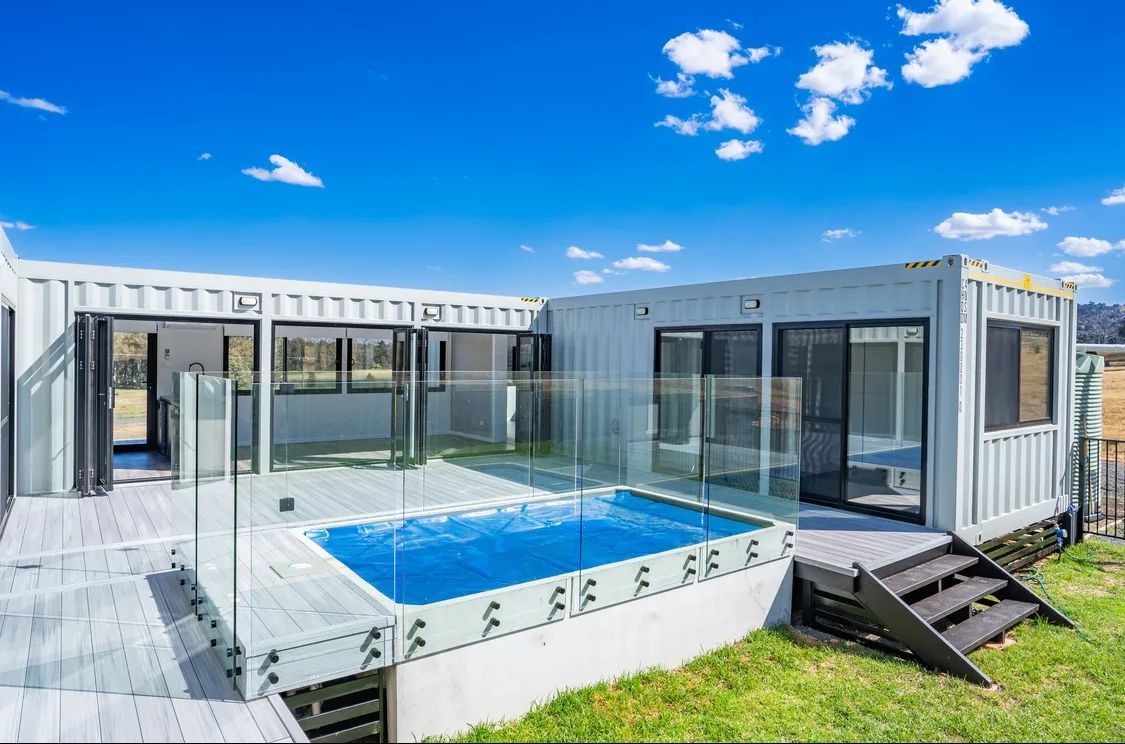Modular Homes vs Converted Shipping Containers – What’s the Difference?
H1: Modular Homes vs Converted Shipping Containers – What’s the Best Choice for Australians?
Introduction
Container homes have exploded in popularity across Australia, but not all container homes are created equal. There are two very different approaches:
- Converted Shipping Containers – second-hand steel boxes retrofitted for living.
- Purpose-Built Modular Homes – factory-engineered modules designed for comfort, safety, and compliance.
At first glance, conversions look cheaper — but hidden costs and compliance risks often outweigh the savings. This guide breaks down the pros and cons, with a focus on Australian building standards, durability, and real-world livability.
What Are Converted Shipping Containers?
- Origin: Standard shipping containers (20ft/40ft) previously used for freight.
- Process: Cut doors/windows, add insulation, wire/plumb, and fit out internally.
- Attraction: Appealing because of low purchase price ($3k–$8k each container).
Limitations:
- Structural integrity is compromised when walls are cut.
- Hard to achieve Australian BAL (Bushfire) and NCC (National Construction Code) standards.
- Prone to condensation, corrosion, and poor insulation.
- Lifespan often only 10–15 years in harsh climates.
What Are Modular Container Homes?
- Origin: Built from the ground up as habitable modules, not recycled freight containers.
- Materials: Light gauge steel frames (G550, AZ150 coating), insulated panels (PIR, PU), engineered roofs, cement floors.
- Compliance: Designed to meet or exceed NCC, BAL-29/BAL-40/BAL-FZ, cyclone ratings, and energy efficiency requirements.
- Lifespan: 40–50+ years, comparable to conventional housing.
Key Differences at a Glance
FeatureConverted Shipping ContainerModular Container HomeInitial CostLow ($3k–$8k base per container)Higher ($45k+ per module)ComplianceRarely compliant without major upgradesEngineered for NCC & BAL complianceInsulationOften thin spray foam, poor R-valuesHigh-density PIR/PU, double glazingDurability10–15 years (corrosion risk)40–50+ yearsCustomizationLimited by 2.4m width, corrugated wallsWider (3.4m+), open-plan layoutsDelivery TimeFast, but often fails council10–16 weeks, certifiedResale ValueLowComparable to modular/traditional housing
Why Converted Containers Often Fail in Australia
- Bushfire Zones: Thin steel walls and basic insulation cannot meet BAL-FZ standards.
- Condensation: Steel + poor insulation = trapped moisture → mould, rust, health issues.
- Council Pushback: Many councils reject applications for “converted shipping containers” as habitable dwellings.
- Width Restriction: Standard container width is 2.4m — too narrow for comfortable living rooms or open spaces.
💡 Case Study: A NSW family bought two converted containers for $60k. After multiple council rejections, they spent an extra $45k on engineering reports, upgrades, and insulation retrofits — yet still couldn’t secure approval.
Why Modular Homes Outperform
- Engineered from the Start
- Designed as homes, not retrofits.
- Steel framing, insulation, roofing, and cladding built for residential standards.
- Council & Lender Acceptance
- Treated as a Class 1a dwelling in most states.
- Easier to finance, insure, and resell.
- Bushfire & Cyclone Ready
- Custom BAL-FZ solutions (non-combustible cladding, ember-proof vents).
- Cyclone-rated tie-downs and structural bracing available.
- Design Flexibility
- Modules can be 3.4m wide or more, giving open living layouts.
- Stackable up to 2–3 storeys with engineered footings.
Cost Comparison: “Cheap” vs “Smart”
- Converted Containers: $60k – $120k (before compliance upgrades).
- Modular Home: $120k – $220k (all-inclusive, certified, compliant).
💡 When factoring in approvals, re-work, and compliance, modular builds are usually the cheaper option long-term.
Real-World Example: Scenic Rim Airbnb
- Converted Container Attempt: Rejected by council due to BAL compliance failure.
- Modular Unit Replacement: Approved within 8 weeks, BAL-FZ ready, and now generating consistent Airbnb income.
FAQs (Schema-Ready)
Q: Can I live permanently in a converted shipping container in Australia?
A: In most cases, no. Councils require compliance with NCC standards that modified freight containers rarely achieve.
Q: Do modular container homes meet Australian bushfire standards?
A: Yes, with the right cladding and glazing they can meet
BAL-FZ (highest bushfire risk rating).
Q: What’s the biggest difference in design flexibility?
A: Converted containers are limited to 2.4m wide, while modular homes can be
3.4m+ wide, allowing open-plan layouts.
Q: Which has better resale value?
A: Modular homes — banks and buyers treat them like conventional housing. Converted containers often lose value quickly.
Conclusion & CTA
While converted shipping containers may seem like a budget option, the real cost of compliance, comfort, and longevity tells a different story.
Modular container homes are engineered for Australian conditions — durable, bushfire-rated, energy-efficient, and fully council-compliant.
👉 Ready to build smart, not cheap?

Modular Homes vs Converted Shipping Containers – What’s the Difference?
H1: Modular Homes vs Converted Shipping Containers – What’s the Best Choice for Australians?
Introduction
Container homes have exploded in popularity across Australia, but not all container homes are created equal. There are two very different approaches:
- Converted Shipping Containers – second-hand steel boxes retrofitted for living.
- Purpose-Built Modular Homes – factory-engineered modules designed for comfort, safety, and compliance.
At first glance, conversions look cheaper — but hidden costs and compliance risks often outweigh the savings. This guide breaks down the pros and cons, with a focus on Australian building standards, durability, and real-world livability.
What Are Converted Shipping Containers?
- Origin: Standard shipping containers (20ft/40ft) previously used for freight.
- Process: Cut doors/windows, add insulation, wire/plumb, and fit out internally.
- Attraction: Appealing because of low purchase price ($3k–$8k each container).
Limitations:
- Structural integrity is compromised when walls are cut.
- Hard to achieve Australian BAL (Bushfire) and NCC (National Construction Code) standards.
- Prone to condensation, corrosion, and poor insulation.
- Lifespan often only 10–15 years in harsh climates.
What Are Modular Container Homes?
- Origin: Built from the ground up as habitable modules, not recycled freight containers.
- Materials: Light gauge steel frames (G550, AZ150 coating), insulated panels (PIR, PU), engineered roofs, cement floors.
- Compliance: Designed to meet or exceed NCC, BAL-29/BAL-40/BAL-FZ, cyclone ratings, and energy efficiency requirements.
- Lifespan: 40–50+ years, comparable to conventional housing.
Key Differences at a Glance
FeatureConverted Shipping ContainerModular Container HomeInitial CostLow ($3k–$8k base per container)Higher ($45k+ per module)ComplianceRarely compliant without major upgradesEngineered for NCC & BAL complianceInsulationOften thin spray foam, poor R-valuesHigh-density PIR/PU, double glazingDurability10–15 years (corrosion risk)40–50+ yearsCustomizationLimited by 2.4m width, corrugated wallsWider (3.4m+), open-plan layoutsDelivery TimeFast, but often fails council10–16 weeks, certifiedResale ValueLowComparable to modular/traditional housing
Why Converted Containers Often Fail in Australia
- Bushfire Zones: Thin steel walls and basic insulation cannot meet BAL-FZ standards.
- Condensation: Steel + poor insulation = trapped moisture → mould, rust, health issues.
- Council Pushback: Many councils reject applications for “converted shipping containers” as habitable dwellings.
- Width Restriction: Standard container width is 2.4m — too narrow for comfortable living rooms or open spaces.
💡 Case Study: A NSW family bought two converted containers for $60k. After multiple council rejections, they spent an extra $45k on engineering reports, upgrades, and insulation retrofits — yet still couldn’t secure approval.
Why Modular Homes Outperform
- Engineered from the Start
- Designed as homes, not retrofits.
- Steel framing, insulation, roofing, and cladding built for residential standards.
- Council & Lender Acceptance
- Treated as a Class 1a dwelling in most states.
- Easier to finance, insure, and resell.
- Bushfire & Cyclone Ready
- Custom BAL-FZ solutions (non-combustible cladding, ember-proof vents).
- Cyclone-rated tie-downs and structural bracing available.
- Design Flexibility
- Modules can be 3.4m wide or more, giving open living layouts.
- Stackable up to 2–3 storeys with engineered footings.
Cost Comparison: “Cheap” vs “Smart”
- Converted Containers: $60k – $120k (before compliance upgrades).
- Modular Home: $120k – $220k (all-inclusive, certified, compliant).
💡 When factoring in approvals, re-work, and compliance, modular builds are usually the cheaper option long-term.
Real-World Example: Scenic Rim Airbnb
- Converted Container Attempt: Rejected by council due to BAL compliance failure.
- Modular Unit Replacement: Approved within 8 weeks, BAL-FZ ready, and now generating consistent Airbnb income.
FAQs (Schema-Ready)
Q: Can I live permanently in a converted shipping container in Australia?
A: In most cases, no. Councils require compliance with NCC standards that modified freight containers rarely achieve.
Q: Do modular container homes meet Australian bushfire standards?
A: Yes, with the right cladding and glazing they can meet
BAL-FZ (highest bushfire risk rating).
Q: What’s the biggest difference in design flexibility?
A: Converted containers are limited to 2.4m wide, while modular homes can be
3.4m+ wide, allowing open-plan layouts.
Q: Which has better resale value?
A: Modular homes — banks and buyers treat them like conventional housing. Converted containers often lose value quickly.
Conclusion & CTA
While converted shipping containers may seem like a budget option, the real cost of compliance, comfort, and longevity tells a different story.
Modular container homes are engineered for Australian conditions — durable, bushfire-rated, energy-efficient, and fully council-compliant.
👉 Ready to build smart, not cheap?
✅ This piece pairs perfectly with the first pillar page. Together they form a content cluster:
- Page 1: Costs & Regulations (top-of-funnel info).
- Page 2: Modular vs Converted (decision-stage comparison).
- Both link to your product pages and case studies → driving qualified leads.




